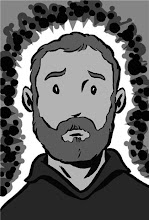Entitled These Are a Few of My Favourite Themes, the set was an odyssey through Adamson’s favourite themes from TV and film (including The Man from UNCLE, Dirty Harry, and Shot in the Dark) and a selection of his own instrumental work. A plethora of guest stars were also on offer, including David McAlmont, Sarah Stanton and the inimitable Nick Cave (who, manic as ever with his waving arms and bared teeth, put me in mind of a militant Magnus Magnussen).
As with the previous evening, Adamson and his band were in awesome fettle, and it was a pleasure to be there. The highlight for me, however, was Adamson’s rendition of Elmer Bernstein's The Man With the Golden Arm. It’s a great track in itself, and it’s been one of my favourite tracks since it appeared on Adamson’s Moss Side Story album, but it was made so much better by the guest appearance of Immodesty Blaize.
The night, however, wasn’t over. As mentioned in the previous blog, Adamson would be reading a short story after the show (a tale of—as he put it—“Griminality and woe”), and I was intrigued to hear what his work would be like.
Half an hour later, and the story had been read to a jazz backing. Once he’d finished, I felt drained—and confused. This story challenged everything I know about writing, from maintaining your perspective, to staying in character, and staying in one tense. Everything about it, technically, was wrong—but it was bloody good.
The story, like the jazz accompaniment, was free and unfettered, and its components parts were tight and so well written as to be astounding. He jumped from first to third person narration with wanton abandon, from tense and character at will, and there seemed to be no obvious plot, instead happy to move from vignette to vignette, all the while painting such a vivid and acutely observed portrait of the dregs of London life it was painful. Exhibiting a startling skill for regional accents, he brought us Poles, Jamaicans, Mancs, Scousers, Cockneys and Brummies as he painted a vivid picture of desperate, down-trodden and devious individuals bouncing off one another in an East-end suburb. His insight into the mind of the obsessive-compulsive main character was a fine an example of “Show, don’t tell” as I’ve ever encountered.
This lead to another sleepless night as chez Stasi—and much introspection since. If Adamson’s story could be seen as an analogy for jazz (free, well-written, crafted, an exhibition of peerless skill), then surely I was wrong about jazz, and finally I was getting an insight into just what it was my Grandfather enjoyed in those records and endless concerts. Thus, by extension, was I wrong about poetry, which I’ve so often likened to jazz? For all my dismissive attitude toward these little snap-shots that “don’t go anywhere”, that “pose and pontificate”, was I blithely ignoring the qualities that make poetry such a widespread and appreciated art-form—and one which is so hard to master? Does my brazen lampooning of poetry say more for my paucity of depth and skill, and an inability to read and decipher subtler texts that aren’t all tits and spaceships?


No comments:
Post a Comment